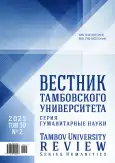Problems of collective farms development during the New Economic Policy
- 作者: Nikolashin V.P.1
-
隶属关系:
- Derzhavin Tambov State University
- 期: 卷 30, 编号 2 (2025)
- 页面: 503-511
- 栏目: NATIONAL HISTORY
- URL: https://ogarev-online.ru/1810-0201/article/view/298967
- DOI: https://doi.org/10.20310/1810-0201-2025-30-2-503-511
- ID: 298967
如何引用文章
全文:
详细
Importance. Based on historiography modern achievements and with the involvement of new archival materials, scientific knowledge on this topic is systematized and expanded. Special attention has been paid to exploring ways to improve the collective farms efficiency in the 1920s. The purpose of the research is to study the key problems of the collective farms development during the New Economic Policy period.Materials and Methods. During the research, both general scientific and special historical methods are used. In particular, comparative-historical, historical-systemic methods are used. Modernization theory is used. Materials from the Russian State Archive of Socio-Political History and the State Archive of the Lipetsk Region are used.Results and Discussion. Modern historiography on the collective farms development during the New Economic Policy period is represented by a wide range of studies, including regional works. The generalization of published scientific works and the expansion of the topic under study through new archival materials made it possible to more deeply study the collective farms formation issue, based on their development difficulties that stood in their way.Conclusion. During the new economic policy, collective farms retained a whole range of problems along their formation way, which limited their development potential. At the same time, in the Russian countryside, the number of productive partnerships for joint cultivation of land, communes, and artels, including exemplary ones, gradually increased. A special place in the rationalization of production was occupied by the introduction of innovations, mechanization of labor, effective land management, and deepening the division there. Along with the objective economic factors of the economic revival of collective farms, their development is influenced by sociopolitical and economic stabilization after the civil war end.
作者简介
V. Nikolashin
Derzhavin Tambov State University
编辑信件的主要联系方式.
Email: nikolashin.vadim@yandex.ru
ORCID iD: 0000-0002-3595-8556
Dr. Sci. (History), Associate Professor of the History and Philosophy Department
33 Internatsionalnaya St., Tambov, 392000, Russian Federation参考
- Babashkin V.V. (2007). Russia in 1902–1935 as an Agrarian Society: Patterns and Features of Domestic Mod-ernization. Moscow, Russian State Agrarian Distant University Publ., 225 p. (In Russ.) https://elibrary.ru/qpiwwb
- Grishaev V.V. (1976). Agricultural Communes of Soviet Russia 1917–1929. Moscow, Mysl’ Publ., 188 p. (In Russ.)
- Danilov V.P. (1988). The 20s: NEP and the struggle of alternatives. Voprosy istorii, no. 9, pp. 3-13. (In Russ.)
- Dyuran D. (2010). Communism with Your Own Hands: the Image of Agrarian Communes in Soviet Russia. St. Petersburg, European University at St. Petersburg Publ., 246 p. (In Russ.)
- Esikov S.A. (2010). The Russian Countryside during the NEP years: on the Question of Alternatives to Stalinist Collectivization (Based on the Materials of the Central Chernozem Region). Moscow, 244 p. (In Russ.) https://elibrary.ru/qposrj
- Konyukov I.A. (1949). Essays on the First Stages of the Collective Farming Development, 1917–1925. Moscow, Sel’khozgiz Publ., 189 p. (In Russ.)
- Sharapov G.V. (executive ed.) (1986). The peasantry in the first decades of Soviet power. 1917–1927: in 5 vols. Moscow, Nauka Publ., vol. 1, 456 p. (In Russ.)
- Nikolashin V.P., Strekalova N.V. (2023). On peculiarities of studying the collective farms activities in the days of the nep on the example of the Tambov gubernia: the 1920s. Vestnik arkhivista = Herald of an Archivist, no. 4, pp. 1173-1184. (In Russ.) https://elibrary.ru/hcymyo
- Panarin A.A. (2013). Role of collective farms in economy of the Don and North Caucasus regions at the culmi-nation of the new economic policy (1924–1927). Vestnik Adygeiskogo gosudarstvennogo universiteta. Seriya 1: Regionovedenie filosofiya, istoriya, sotsiologiya, yurisprudentsiya, politologiya, kul’turologiya = The Bulletin of the Adyghe State University. Series “Region Studies: Philosophy, History, Sociology, Juri-sprudence, Political Sciences and Culturology”, no. 2 (118), pp. 51-56. (In Russ.) https://elibrary.ru/rfuewv
- Demchik E.V., Savitskaya A.E. (2018). The first communes in Altai (1917–1927): economic activity and gov-ernment support. Istoriko-ekonomicheskie issledovaniya = Journal of Economic History & History of Econom-ics, vol. 19, no. 2, pp. 198-221. (In Russ.) https://doi.org/10.17150/2308-2588.2018.19(2).198-221, https://elibrary.ru/uvoktv
- Danilov V.P. (1979). A Soviet Pre-Collective Farm Village. Population, Land Use, Agriculture. Moscow, Nauka Publ., 359 p. (In Russ.)
- Goncharova I.V., Chuvardin G.S. (2018). Communes of the Central Chernozem Region – from “war Commun-ism” to collectivization: conception and implementation. Krest’yanovedenie = Russian Peasant Studies, vol. 3, no. 4, pp. 105-122. (In Russ.) https://elibrary.ru/ysuihb
- Gospodarenko N.M. (1997). Agriculture in Crimea under the new economic policy. Kul’tura narodov Pricher-nomor’ya, no. 1, pp. 106-109. (In Russ.)
- Ivanov A.A., Solov’ev A.A. (2016). Collective farms in the village of Mari autonomous oblast in 1920. Vestnik Mariiskogo gosudarstvennogo universiteta. Seriya: Istoricheskie nauki. Yuridicheskie nauki = Vestnik of Mari State University. Chapter: History. Law, vol. 2, no. 1 (5), pp. 21-28. (In Russ.) https://elibrary.ru/vxkmtj
补充文件









